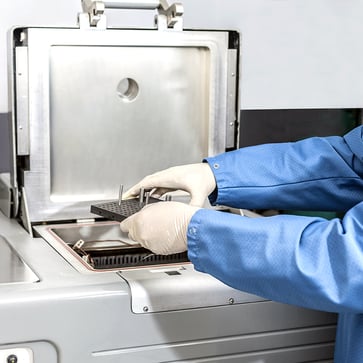Surfaces to be soldered in a flux-less environment must be coated prior to soldering. The most common solderable metallic coatings that are used in the electronics assembly industry are gold, silver, platinum, palladium, nickel, copper, tin and tin-lead. These coatings may be applied using vacuum deposition, sputtering, thick film or plating processes. Plating is probably the most commonly used of these processes.
It is very important that plated deposits for soldering applications be free of porosity defects and chemical contaminants that adversely affect solderability. Stringent detailed plating requirements should be imposed so that assembly level solderability problems can be avoided.
Plating deposits designed for the following applications are not necessarily solderable:
- Corrosion protection
- Wear resistance
- Abrasion resistance
- Decorative finish
- Dry lubrication
- Masking for heat treatment stop-off shield
- Barrier between base material and an outside deposit
If the plating supplier is not made aware that the order is for a soldering application, or is not given proper plating requirements, they may use any plating process that happens to be convenient. That particular process may not be capable of producing solderable deposits. It may be well suited for one or several of the applications previously listed, but totally inconsistent with soldering applications.
If costly problems with solderability are to be prevented during subsequent assembly operations, explicit plating requirements must be specified on all applicable detail-engineering drawings. These requirements must also be included on all plating purchase requisitions and/or manufacturing routers as applicable. Nonexistent or incomplete plating requirements often result in excessive rework and scrap.
Recommended Plating Instructions
Since there are numerous plated material/plating requirement combinations, only the more commonly used combinations are addressed in this blog. The following callouts will provide solderable plated deposits for the solder alloys shown:
- For solderable gold plate when gold-tin, tin-lead, lead-indium, tin-indium, lead-tin-silver, lead-indium-silver or tin-silver solder alloys are used:
- Underplate with solderable nickel sulfamate per QQ-N-290, 50-150 micro inches thick.
- Followed by: Gold plate per Mil-G-45204,Type III, Grade A, 50-100 micro inches thick (Class 1).
- For solderable gold plate when gold-germanium solder is used:
- Wood’s nickel strike per QQ-N-290, 5-50 micro inches thick. The nickel plate thickness shall not exceed 50 micro inches.
- Followed by: Gold plate per Mil-G-45204,Type III, Grade A, Class 2, 150-250 micro inches thick.
- For solderable silver plate when lead-tin, lead-indium, tin-silver, tin-indium, lead-tin-silver or lead-silver solder alloys are used:
- Underplate with solderable nickel sulfamate (no brighteners) per QQ-N-290, 50-150 micro inches thick.
- Followed by: Plate solderable silver per QQ-S-365, Type I or II, Grade B, 300-500 micro inches thick.
- For electrolytic nickel plate applications when lead-tin, lead-indium, tin-silver, tin-indium, lead-tin-silver or lead-silver solder alloys are used:
- Plate solderable nickel sulfamate (no brighteners) per QQ-N-290, 150-300 micro inches thick.
- For electroless nickel plate applications when lead-tin, lead-indium, tin-silver, tin-indium, lead-tin-silver or lead-silver solder alloys are used*:
- Plate solderable nickel-boron per AMS-2433,Type 2, 150-300 micro inches thick.
*Electroless nickel-phosphorus plate shall not be used for soldering applications. If the phosphorus content should exceed 10%, the resulting deposit may be nonsolderable.
Download these resources to learn more:
| SST 5100 Vacuum Pressure Furnace Brochure | SST 3130 Vacuum Pressure Furnace Brochure | Achieving Low Voiding with Lead Free Solder Paste for Power Devices |
 |
 |
 |